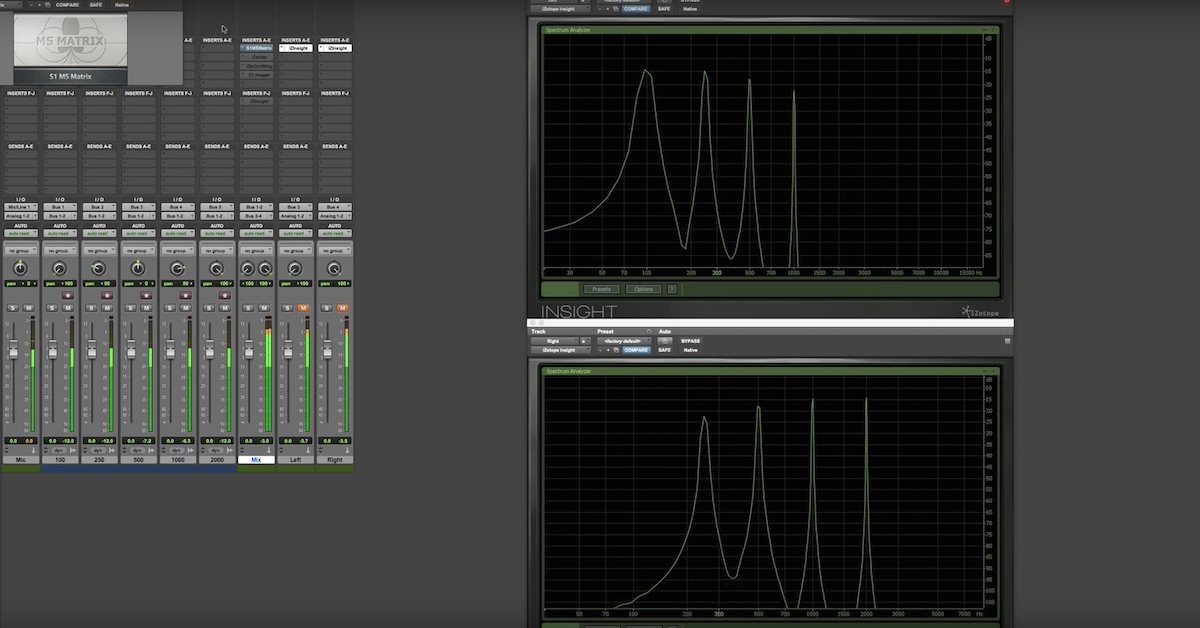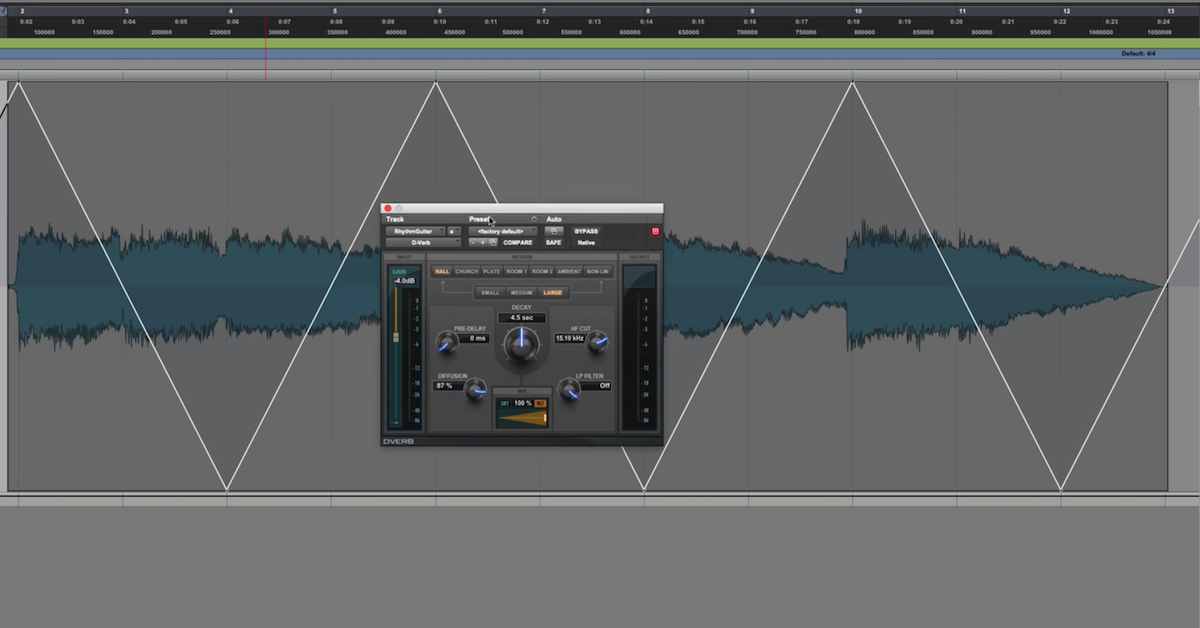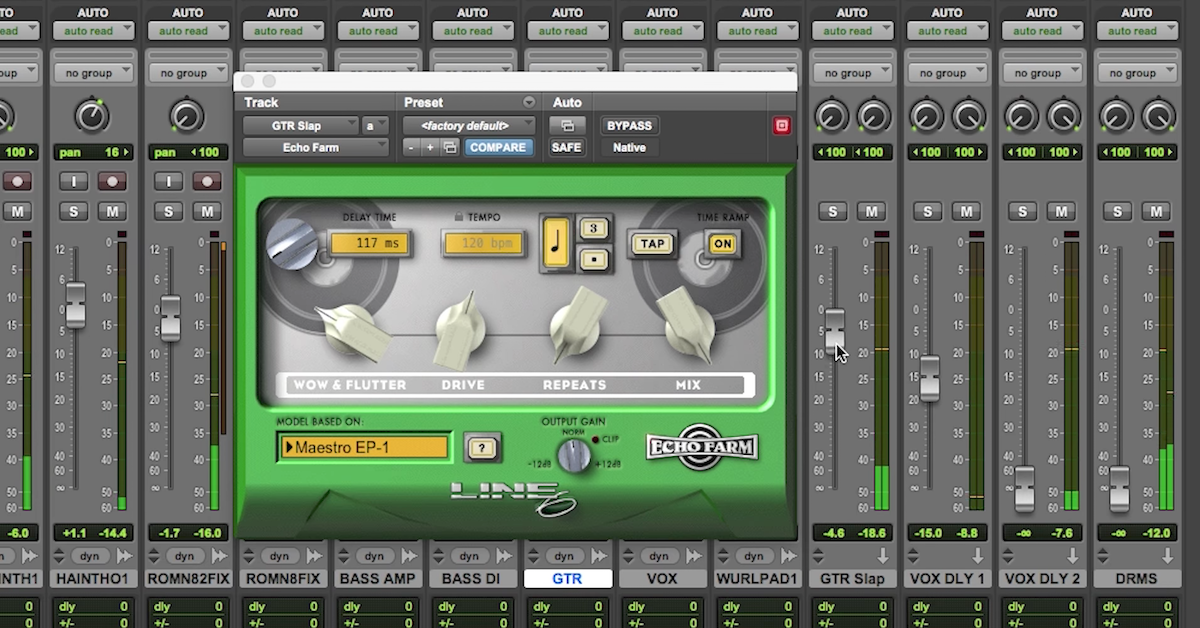How to Use Panning to Your Advantage for Mixing
Article Content
One of the simplest ways to create clear, spacious-sounding mixes is the proper use of panning. Beneath are some rules of thumb I follow when panning my tracks, with some additional information on how to make the most of the stereo field.
Let’s start with how I generally pan instruments.
Kick & Snare
While I love the stereo Beatles mixes with the drums hard-panned to one side — the times, tastes and technology have changed and unless it’s for a special purpose, my kicks stay straight up the middle. Sometimes, however, I will trigger or lay in samples for the purpose of adding roominess to a kick and/or snare drum. Those samples may have been recorded in stereo, and I will leave them as such to add width and depth to the drums. I do make an effort to keep elements with large amounts of low-frequency content away from the sides, generally speaking, so if I do place a roomy, stereo kick sample into the mix, I may high-pass it.
Certain styles of music (think EDM or Pop) use more “sound design-ey” kick and snare drums that were perhaps partially synthesized, or are a collage of multiple layers — and these designed drums might even have some side-to-side movement or stereo reverb effects baked into the sample. In this case, I call it by ear — if the drums work with the rest of the instrumentation, I leave them as is. If not, I’ll narrow their stereo width or make them mono entirely.
Overheads & Rooms
I always pay close attention to the perspective of the drums. Sometimes audience perspective works, and sometimes it needs to be from the drummers’ vantage point. It all depends on the interplay of the drums with the other elements, and how the arrangement was built from the ground up. Hopefully, the recording engineer and/or producer has provided direction as to which perspective to use.
As a recording engineer, I’ll record both mono and stereo overheads and room microphones, as I like having options when it reaches the mix stage. It’s great to keep the drums more centered during verses, and bring in wide stereo overheads and rooms during the choruses. Generally, I pan these stereo tracks pretty wide, usually 75% to the left and right. I pay special attention to polarity and phase relationships, and to how the different frequencies of these stereo drum recordings interact with the other elements.
Toms
I find toms panned all the way to the left and/or right to be somewhat distracting, so I usually keep them between 40-80% panned. There are always exceptions, and crazy wide toms can be a useful special effect. Again, I pay close attention to how these direct drums are interacting with the overheads and rooms, and if I’m working on an EDM track that includes wild, synthesized layered toms, I throw out the rules and follow what I believe best serves the song.
Hi-Hat
I sort of despise hi-hats, especially open ones. They are usually overly-bright, noisy and generally desperate for attention. If the stereo field of the drums is well established by the overheads and/or room, I’ll even keep the direct hi-hat level low, or mute the signal entirely. I do love dance-y 16th-note hats as long as they’re grooving correctly. Hi-hats are panned depending on how the perspective of the drums is set, and I usually keep them between 60-80% to the side.
Electronic hats are a bit different — some stay close to the center, some are made to be stereo, some are hard-panned, and some are subject to auto-panning and can move around the stereo field.
Bass
Typically, electric bass stays straight up the middle, but sometimes a bit of subtle roomy width can add much-needed depth to a bass (just as it can kick drum) so from time to time I’ll use a reverb plugin (or re-amping) to create a “bass room” track. This track will likely stay low in the mix, and may only be used during certain sections for spatial emphasis.
Synth bass is another beast altogether — subby, warm-sounding synth basses I’ll likely keep up the middle, but for ripping, biting bass synths, sometimes keeping them wide is the way to go, especially if they were designed to have unique stereo properties.
Guitars
Having been an audio production and sound design professor for the greater part of the last decade, I can’t tell you how many mix critiques I’ve given for student mixes that have doubled, distorted electric guitars panned straight up the middle. How exactly is the vocal supposed to thrive, let alone exist, amongst such chaos?
Double-tracked guitars are panned 100% in my world. Sometimes recording engineers will get creative and use multiple direct mics, add room mics, etc. In my opinion, guitars are so upper-mid frequency-dominant that I always try to move them out of the way of the lead vocal, and hard panning is generally the solution.
If there’s only one single-miked guitar track, I try to balance it against other elements like keyboard, synths, horns or even hi-hat. If there’s a single stereo-tracked acoustic, I determine the width by ear. I may pull the stereo field in a bit, and spread it out during choruses or moments that are meant to be bigger.
Lead guitars tend to be very close to center (if not dead-center) unless they are doubled in which case I’ll start at about 10% panned apart, and experiment with different widths until I’m satisfied.
More Guitar Mixing Tips here.
Synths & Keys
There are so many variables here due to the versatile sonic nature of synthesizers and keyboard instruments. On a recent mix, I was committed to featuring a synthesizer part by keeping it stereo, but it was simply too busy and ended up overshadowing the vocal. I ended up panning it mostly to the right, and all of a sudden the entire song came to life.
I suppose the key is to manage the panning of your midrange instruments with a lot of care. Certain pads and organs benefit from being stereo, but it depends on what else is happening. Stereo-miked pianos are a beautiful sound on their own, but can benefit from not being spread 100%, or if emphasized a bit to one side when placed in the context of a mix.
I regularly use an auto-panner (Soundtoys Panman) to give organs or pads a bit of movement and to allow the lead vocal to really own the center.
Horns, Woodwinds & Strings
For arrangements that include orchestral elements such as these, I reference a traditional orchestra seating chart and then consider if panning them in that manner is for the benefit of the mix. If it’s a reggae tune with horns, I’ll lay them out as the band would be on stage, again considering if my mix is from the audience or musicians perspective. If they are solo elements but are present throughout the course of the song, I pan them considering how their timbre relates to other components of the instrumentation. For example — if I have a solo viola, I’ll try to keep it away from the acoustic guitar, and solo trumpet I try to keep apart from hi-hats, etc.
Vocals
There are so many ways to approach vocal production, but one consistent in my mixing is that if there’s a lead vocal, it’s going to be right up the middle. An exception would be if there was a double-tracked lead, sometimes I may pan them each a bit symmetrically off-center. Ad-libs may also be a touch off-center, if not panned significantly.
My approach to panning backup vocals isn’t so simple— with pop sessions it’s common to have dozens of layers of vocal tracks to work with, and so I’ll place these layers all across the stereo field.
A technique I often use is to keep backup vocals a touch shy of 100% wide during verses and spread them out entirely during the choruses.
More Vocal Mixing Tips here.
Reverb & Delay
I use both mono and stereo time-based effects on vocals. Similar to my approach to backup vocals, transitioning from mono or not-entirely-wide reverbs and/or delays during verses, to fully-wide effects in choruses can add a satisfying contrast to your mixes.
Vocal delay, in particular, can cloud up your mixes if you don’t thoughtfully distribute them across the stereo spectrum. I’ll decide different widths for delays that have different note values (eighth, quarter, half-note, etc.) in an effort to create separation and maintain clarity in my mixes.
One of my favorite techniques for epic, power-ballad individual tambourine hits is to pan the recorded tambourine to one side, send it through a reverb and pan that signal to the opposite side. I then time the pre-delay to taste (usually something similar to a sixteenth or eighth-note works best).
Summary
How I place elements in the stereo field is, of course, dependent on the arrangement and what I believe the song needs. As I mentioned, I’ll also change how elements are panned throughout the course of the song. Additionally, I’ll use a combination of auto-panners, doublers, mid-side processing and wideners to maximize my usage of the stereo spectrum for the benefit of the mix.






